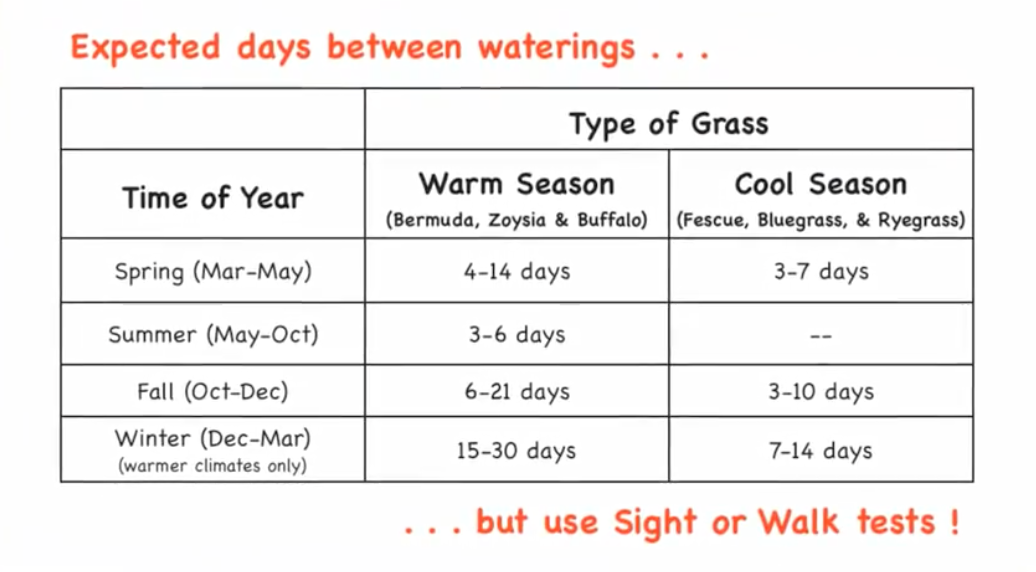Lawn Watering Tips: Better Results and Less Water
RIGHT TIME
One of the first things to remember, is to only water your lawn when it actually needs watering.
There are two ways you can tell when your lawn is ready to be watered. The first is the “sight test,” which basically involves watching your lawn and looking to see when it begins to turn from its normal green color to a bluish-gray color. The other method is the “walk test.” If you walk on your lawn and you can see your footprints because the grass blades are not springing back where you have stepped, then this is a sign that your lawn needs watering.
Here is a chart that shows, on average, the expected number of days between waterings for different times of the year and different types of grass. And although this gives a general idea of the timings to expect, as mentioned earlier, you will want to use the sight or walk tests to determine when your particular lawn actually needs to be watered.

So once you have determined when your lawn needs to be watered, the next question is “what is the best time of day to do your watering?” The answer is that the best time of day is during the early morning, between 5 and 10am. This is when it is cooler and typically less windy, and so you will have less evaporation; so more of the water can get into the soil where it is needed. And the very best time is at 5 am before the heat of the sun starts.
The times you definitely want to avoid watering your lawn include:
-
When it is windy, which causes increased evaporation.
-
Before mowing, as wet grass does not cut as cleanly, and it "clumps" together which makes mulching more difficult for clippings to return to the soil.
-
Before fertilizing, as this causes the fertilizer to stick to the blades of the grass, rather than falling down to the soil where it is needed.
-
And lastly, before it rains, as obviously this will be a waste of water.
To help you avoid watering on days prior to when it is forecast to rain, here are a couple of free rain forecast alerts that you can sign up for:
-
Weather Channel email alerts:
-
Weather Channel app (iOS):
https://itunes.apple.com/us/app/the-weather-channel-tracker/id295646461?mt=8
-
Weather Channel app (Android):
https://play.google.com/store/apps/details?id=com.weather.Weather&hl=en_US
RIGHT AMOUNT
So now that we have discussed how to determine the right time to water your particular lawn, let’s now look at how to determine what is the right amount of water your lawn needs during each watering.
Shown here are the 5 steps for determining how long to water your lawn each time:
First: Wait until your lawn actually needs watering.
Next: Turn your sprinklers on the way you normally would.
Then: Run your sprinklers so that each area of your lawn is watered for 15 minutes.
Next: Use a shovel or lawn probe to check to see if the water has penetrated down to at least 6-10 inches into your soil. It is best to check in several locations to see if your watering rates are consistent across different parts of your lawn (see types, costs, and reviews of: lawn probes). If they are not, then you may need to adjust your sprinkler heads.
And then lastly: If your soil is not wet deep enough after watering the initial 15 minutes, then run your sprinklers another 10 minutes, and repeat steps 4 and 5 as needed until you have determined the watering time that’s required to soak down to 6-10 inches of soil, for your particular lawn (see types, costs, and reviews of sprinklers).
The reason for determining the proper watering time for your particular lawn is that there are problems with both watering for too short of a period, and with watering for too long.
Watering for too short of time can cause what is called “shallow root syndrome.” This is when only the top layer of soil gets watered, and therefore the roots of the grass don’t go down deep enough. This condition leaves your grass more susceptible to drought conditions and to certain diseases. Shallow watering also encourages weed germination, which fights with your grass.
On the other hand, watering for too long of time wastes water, of course, but is also harmful to your lawn, and causes problems like:
-
Turning grass a lighter green or yellow color.
-
Causing young shoots to wilt.
-
Promoting excessive lawn growth, and
-
Promoting fungus, algae, and mushroom growth.
OTHER LANDSCAPE WATERING NEEDS
And just to briefly touch on the watering needs of other parts of your landscape: small plants in your yard should be watered down to 1 foot deep; shrubs, about 2 feet deep; and trees about 3 feet deep.
SUMMARY
We hope this video has shown you how to get the most benefit for your lawn from using the least amount of water, by helping you to understand how to determine the right time and the right amount of watering for your particular lawn.
Related Articles . . .
Lawn Mowing Tips for Nice Lawns & Personal Safety
Whether you do-it-yourself or hire a service, when done wrong, lawn mowing can damage your lawn, making it more susceptible to diseases. And if you do-it-yourself, lawn mowing also poses quite a few safety risks that you definitely want to avoid.
Guide to Automatic Sprinklers
If you have an automatic sprinkler system for your lawn, this article and video will help you understand how your system works, how to winterize, and some operating tips for getting the most out of your system.
Spring Lawn Care Guide: the DO's and DON'Ts
Whether your approach to lawn care is do-it-yourself, or you are fortunate enough to have a service do the work for you, this article and video give you a quick list of springtime DO's and DON'Ts for taking proper care of your lawn.
Late Spring Lawn Care Guide
The needs of your lawn in late spring are very different than early spring. This article and video explain what, why, and how to fertilize during late spring for a healthy lawn.
What Your Lawn Needs During Autumn
Autumn is an important season for lawn care, because the cooler temperatures provide good conditions for strengthening your lawn, and proper care will both prepare it for the rigors of winter, and help it to get off to a good start in the spring.









